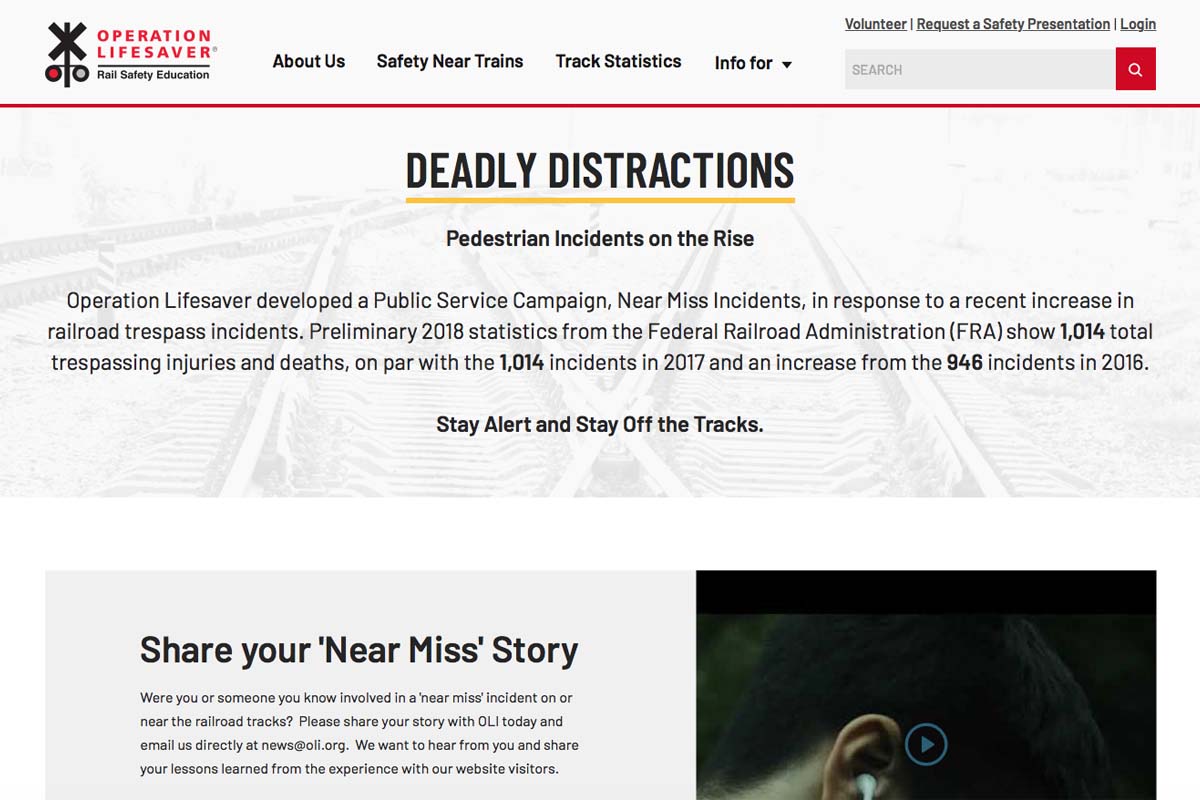“Walking on the railroad tracks is considered trespassing – it’s against the law,” says Executive Director Rachel Maleh. “This new PSA demonstrates, in a very compelling way, the potential dangers pedestrians put themselves in by being distracted and walking on or too close to the tracks.”
Maleh noted that funding for the PSA, its initial digital distribution and a pilot project with major railroads in Cook County, Illinois to track near miss pedestrian-train incidents was provided by the Federal Railroad Administration.
Additional funding to continue distribution of the PSA campaign to targeted audiences will be provided by a grant from the Posner Foundation of Pittsburgh.
“We want people to know that there are real and tragic consequences when people choose to walk on the railroad tracks. Near miss incidents are preventable, as are trespass casualties and deaths. This new PSA campaign is intended to bring attention to the issue and encourage pedestrians to make life-saving decisions near the tracks,” Maleh says.
Operation Lifesaver developed this new PSA in response to a recent increase in railroad trespass incidents. Preliminary 2018 statistics from the FRA show 1,014 total trespassing injuries and deaths, on par with the 1,014 incidents in 2017 and an increase from the 946 incidents in 2016.
“Operation Lifesaver’s mission is to end collisions, deaths and injuries at highway-rail grade crossings and on rail property,” Maleh notes. “This new video addresses near miss trespass incidents and the role that behaviors such as wearing headphones and being distracted by phones and other digital devices play for people who aren’t paying attention to their surroundings.”
For more information, go to oli.org/near-miss.















Another way would be for it to get some advertising done on social and streaming media. Google, Hulu and others that have ads during shows would be an excellent avenue for younger viewers to see it more.
Operation Lifesaver and other PSAs (such as “don’t text and drive,” “don’t drink and drive,” “always buckle up,” etc.) certainly are done with the best of intentions, but I wonder just how effective they really are. When PSAs are run on TV or radio or posted on billboards, how much of the audience notices them or just tunes them out. (I know that my wife and I both routinely tune out most “regular” TV ads, unless they are sufficiently clever or humorous — like the “avoiding mayhem, like me” insurance ads.) And even for those who notice the PSAs and pay attention to them, many will think to themselves something like this — “Well of course, I know that. It’s obvious or common sense.” But for many people, there’s a vast divide between “knowing” something and actually acting according to what they think they know.
It seems to me that the most effective place to push Operation Lifesaver is in the schools, all the way from grade schools to high schools. For one thing, such a presentation would be a break from regular classroom activities, and for many students any break from regular classroom activities is a plus, and thus an attention getter. (Should this be the case? That’s a question for an entirely different discussion about education in this country.) Start with the lower grades, and make the presentations more vivid and graphic for the older students. I think this type of campaign would be more productive in the long run than targeting current adults via TV or radio or billboards.